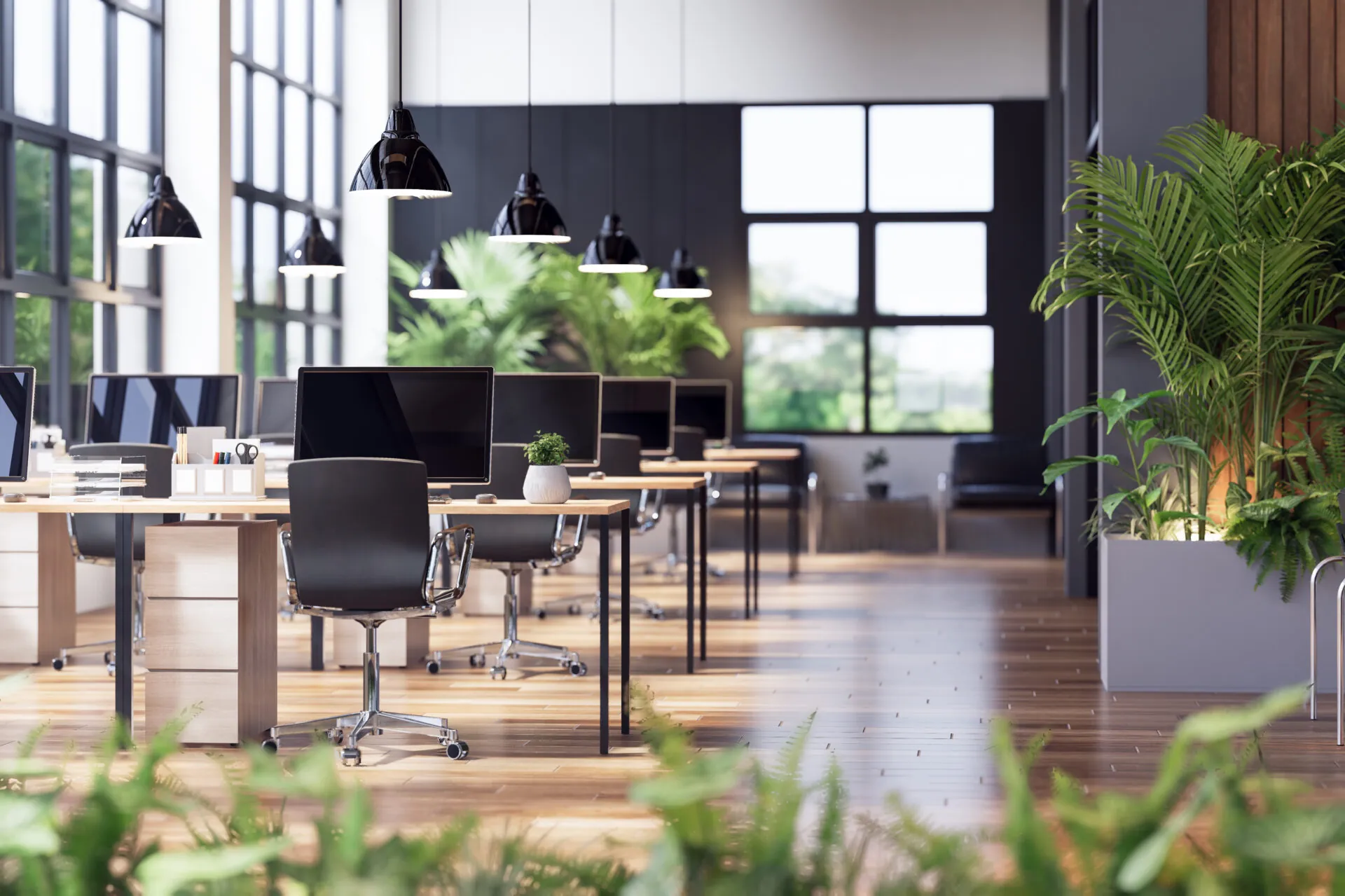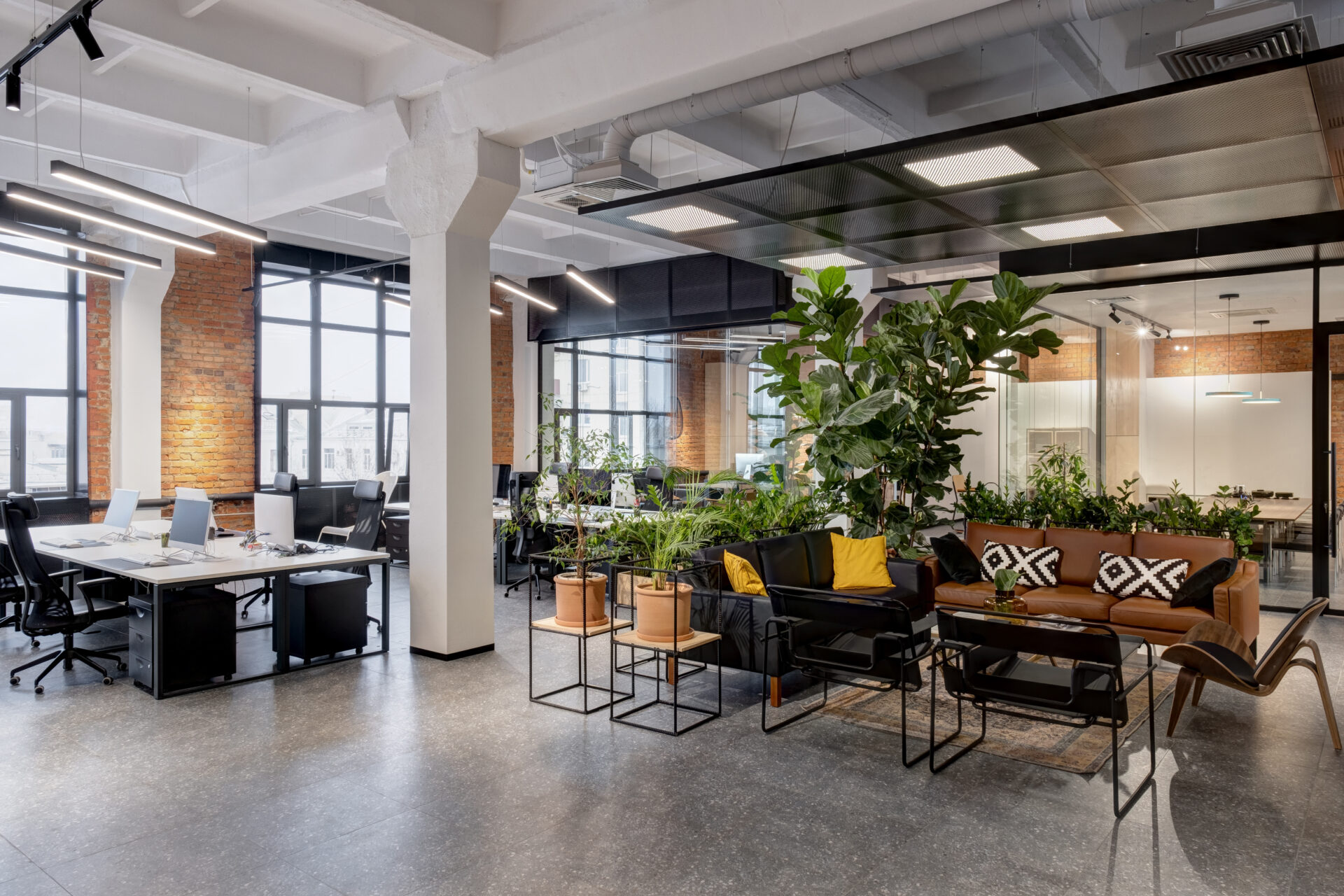
Preserving Productivity with Healthy Workplaces
We’ve always considered workplace productivity the golden metric because it relates to growth, worker satisfaction, and retention. We have recently seen how digital tools can lead to time efficiency, continuity, and effectiveness while working from home. The area of productivity that real estate and facilities teams can have the most impact on is in the health and design of the work environment. This may not seem like an obvious productivity indicator, but we’ll reveal how this is below.
Many of you have been asking about measuring workplace productivity lately. A very quick and dirty way to calculate productivity is taking the total output (revenue) and dividing it by the total inputs (employee hours or wages). This gives a baseline indication of productivity from which an organization may fluctuate. When removing all economic variables, productivity is about the efficacy of the inputs (employee hours). In the workplace and facilities field, we may not study the revenue variables, but we do know quite a bit about what leads to healthy, sustained work overtime, or the variables impacting the inputs! That is what we call “engagement” today.
Only 35% of Americans are Engaged at Work
Even before the added stress of a global pandemic, only 35% of Americans reported they are engaged at work, and 75% of employees listed stress as their #1 health & productivity concern. All of this leads to actively disengaged employees which cost the U.S. $483 to $605 billion each year in lost productivity.
Churn, turnover, or burnout is the most expensive and probable outcome of stressful, or excess working hours. Losing an employee, then hiring and training its replacement costs an organization upwards of 2.15x their annual salary. Losing an employee can be due to any number of issues but what should be highlighted is that the cost of losing an employee from increased (stressful) productivity resulting in burnout may exceed the value of their increased productivity over that period of time.
To stimulate productivity and effectiveness, you have to dig deeper. Let’s explore some topics.
Design “Water Cooler” Moments in Moderation:
As I was writing this piece, I sat down to read the May 2020 issue of Bon Appetit. In Adam Rapoport’s Editor’s Letter, he surmises that “going to work” at 1 World Trade Center pre-Covid19 was perhaps too distracting for him to write his Letter— too many meetings, tapping away on the laptop at daily tasks, “dipping into the BA Test Kitchen” which was full of samples, etc. Though the elements in the office which connect us with our teams are known to be important, they have to be proportionate to undisturbed work. Water cooler moments can’t happen all day long!
Dynamic workplaces have been a leading trend in workplace design after the fall-out of the open office design. We aren’t the same every day of the week, and (hopefully) our work is different day to day. This means we should not actually have routine environments, routine schedules, or routine surroundings. The stimulus is important, but peace is also paramount in preserving workplace productivity.
When designed well, a dynamic workplace supports workers with the task at hand and the mood of the day. Stimulating environments are what spark curiosity and a-ha moments. Peaceful and healthy work environments are what we seek when putting those ah-ha thoughts into action! When these elements are in balance is when we can sustain output over time or productive work. In our new R-Zero Return guide, we highlight the steps necessary to reconfigure and design for a safe and healthy workplace. Use this opportunity to consider a diversity of positive work environments that support productivity.
Hit the Reset on Meetings:
My theory on meetings is that often people take them to switch up the day, so they don’t have to come up with tasks to do. As a leader with no boss, I know I do this from time to time. It creates some structure in the day, and provides some stimulus that I would otherwise have to create for myself. I loved a recent podcast by Seth Godin challenging us to reconsider our meetings. In returning to the office this year (or next), we have an opportunity to hit the reset button on our weekly calendars and challenge each event! As far as offices are concerned, 35% of scheduled meetings end up in no-shows. This presents a massive inefficiency problem in the workplace. Everyone can contribute to resetting the bar on this problem in 2020 and on.
Workplace Productivity and Health are Directly Related:
According to a new book called Healthy Buildings by Joseph Allen and John Macomber, we spend at least 70% of our lives indoors. So how could we overlook our environments as factors in our effectiveness? His research discovered that worker performance increases by 1.7% every time you double the amount of outdoor air delivered into the office. They later went on to find out that 57% of sick leave across 40 buildings was due to poor ventilation. Now THAT is a workplace stimulus if I’ve ever heard one.
Getting down to the numbers, when accommodated for, these environmental factors can reduce absenteeism up to four days a year. Unscheduled absenteeism costs companies $2,650 per salaried worker per year on average. Multiply this for a 15k headcount organization, and we’re looking at roughly $40M/year.
In Chapter 6, Healthy Buildings deeply explores 9 pillars of what makes an environment healthy and those impacts on productivity: Ventilation, Air quality, Thermal health, Moisture, Dust & Pests, Safety & Security, Water Quality, Noise, and finally, Lighting & Views. By improving just 3 of these 9, it is estimated that there would be $20Billion worth of impact to the US economy. Most significantly, this impact relates only to employee productivity (or the inputs discussed earlier), not to increased product sales, consulting practices, construction, etc.
Protecting staff from the spread of coronavirus is of utmost importance today. Moreover, our physical health directly relates to our ability to perform optimally without burning out. Here are our suggested practices which will help you create a healthier workplace, and foster productive healthy employees at the same time.
1. Improve Air Circulation:
Coronavirus is known for being an airborne virus. Therefore air quality is critical. Swap out your air filters for MERV 13 or higher rated filters. In the meantime, suggest that your staff use proper air filtration at home.
2. Optimize Thermal Health:
Using occupancy real-time data to understand work patterns can often reveal hot or cold environments. How? Because people vacate them at certain times every day!. A fluctuation of just 4 degrees can have a 9% impact on a company’s bottom line. When it comes to temperature, everyone is different because we operate at different core temperatures and have different metabolic rates, but consistency is key.
3. Highlight Nature:
the science speaks and bilphillia is the real deal. We’ve all heard the staggering hospital study comparing patients staring at concrete to those looking out at nature. My favorite piece of scientific research is around how pine forests make you smarter- Pine needles release natural aerosols in the afternoon sun that are loaded with oxygen and that fresh oxygen is like a flush for the brain! Encourage your staff to take walks, look at the organic shapes of nature (even if through VR or video), breathe fresh air, or close their eyes with some pink noise or nature sounds.
4. Clean Everything:
Dust and germs are invisible threats related to the spread of a virus and to our overall immune function. They get in our body by breathing, touching, and eating/drinking. Use a HEPA vacuum to ensure you’re capturing all dust and allergens. Clean all surfaces regularly but be mindful of the chemicals you’re using so as to not create another problem by solving one! Encourage your staff to do the same at home.
Maintain 40-60% Relative Humidity:
Mold is another invisible threat that can significantly impact performance. Relative humidity may also play a role in the spread of any virus. Know your facts and try to keep your air around 40-60% relative humidity to suppress the spread of a virus while keeping occupants comfortable.
Productivity has the potential to soar as new work styles emerge in new coronavirus-aware workplaces. We think time spent in the office is going to be much more intentional—it will have to be. Staff will also have the freedom to establish work patterns and schedules that work for their own circadian and family rhythms. Kids will go back to school, eventually, meaning that working from home could actually be a productive alternative when the tasks at hand are deep thought tasks that demand hours of concentration with a lunchtime walk to clear your head.
Final Thoughts
Split WFH and office work schedules could be the shift we’ve needed to truly accelerate workplace utilization as we shift to more shared spaces optimally designed for the tasks at hand. When it comes to productivity, it’s irrelevant to “measure” productivity on a daily basis. I believe that most people want to be efficient- we’d rather finish our work in 8 hours than 10. This work from home experiment is allowing us to see the elements of life that we value outside of work, thus driving the desire to be more efficient. What is important is to measure the impact of output against factors you can control like workplace design & health. Above all, the health of our environments can have a profound impact on our perceived safety, immune function, and thus overall performance. It will take trust, self-reliance, discipline, and honesty. It will take an entirely new management style and a refined facility maintenance model. But, those ah-hah water cooler moments will be that much more magical (and spacious).
More posts you might like
-

Why should I improve indoor air quality (IAQ) & indoor environmental quality (IEQ) in my buildings?
The Importance of Healthy Indoor Air Quality Clean air and proper ventilation indoors is crucial for the creation of high-performance work places, classrooms, and healthcare environments. It’s also essential in fostering comfort, productivity, and well-being for your building occupants. Imagine walking into a building optimized for health and comfort. The air feels fresh and light. […]
-

How to Improve Indoor Air Quality in Your Buildings
As a building owner or operator, ensuring optimal indoor air quality (IAQ) in your spaces is essential for the well-being and productivity of your tenants and occupants. To help you get started, here’s a guide to ensure you are meeting indoor air quality standards across your real estate portfolio. Understanding Indoor Air Quality Standards To […]
-

The importance of indoor air quality testing in office buildings
In today’s workplace, ensuring a healthy and productive environment for employees is crucial. One of the most significant factors influencing workplace well-being is indoor air quality (IAQ). As part of our focus on smart buildings, R-Zero offers advanced indoor air quality testing solutions like the R-Zero IAQ Monitor, designed specifically for enhancing occupant comfort and […]

